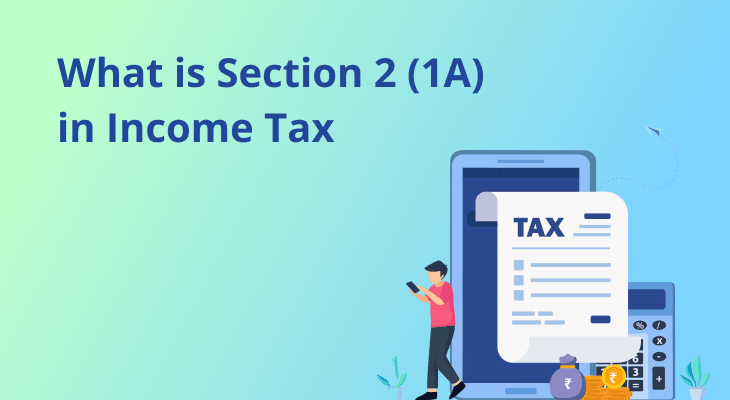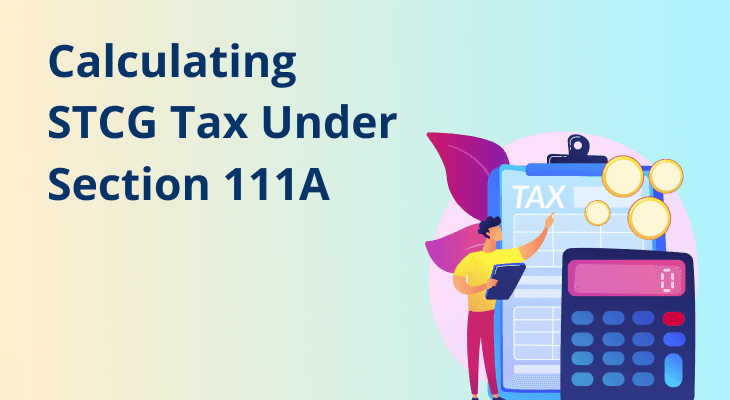
What Is Section 2 (1A) In Income Tax?
Agriculture remains an essential activity across India, and the government recognises its importance by offering relief under the Income Tax Act. If you derive earnings from farming or related land activities, it helps to understand how Section 2 (1A) defines agricultural income for tax purposes. Only certain types of revenue, such as rent from farmland used for cultivation, proceeds from simple processing of crops, or compensation for compulsory acquisition, qualify for exemption under agricultural income tax rules. By understanding the conditions set out in Section 2 (1A), you can ensure your agriculture taxation claims are accurate and compliant.
In the following sections, you will learn what types of receipts fall within this definition, the key criteria to meet, and how to report exempt income correctly, helping you make informed decisions about your farming finances.
What Is Section 2(1A) Of The Income Tax Act?
Section 2(1A) establishes what the law recognises as agricultural income. Only amounts satisfying this definition qualify for exemption under Section 10(1). Broadly, the Act identifies the following:
Rent or Revenue From Agricultural Land
Any sum you receive from letting land on which genuine farming occurs. The sale of land itself does not qualify.
Income From Agricultural Operations
- Basic operations: ploughing, sowing, transplanting.
- Subsequent operations: weeding, pruning, harvesting.
- Nursery activities: sale of seedlings and saplings, irrespective of direct soil operations.
Processing Produce To Make It Marketable
You may clean, dry, grade or pack the output from your farm provided the essential character remains unchanged.
Sale Of Agricultural Produce
Proceeds from selling raw crops, fruits, vegetables, or saplings grown on your land.
Compensation For Compulsory Acquisition
Amounts paid by government authorities when acquiring farmland for public projects.
Income From Farm Buildings
Rent from barns or farmhouses on or adjacent to your agricultural land, subject to specified municipal and distance criteria (for example, within 2 km of a town with a population of up to ₹1 lakh).
Why It Matters
For FY 2025‑26, the new tax regime raises the basic exemption limit to ₹4 lakh for all individual taxpayers, while the old regime retains a ₹2.5 lakh exemption for those under 60. Although agricultural income itself remains exempt, if the sum of your non‑agricultural and agricultural income exceeds these thresholds, you will owe tax on the non‑agricultural portion. Hence, section 2(1A) is crucial. Only income that strictly meets its definition enjoys exemption under the Income Tax Act.
Key Conditions For Income To Qualify As Agricultural Income
Income Must Arise Directly From Land Used for Agriculture
The land must be used for cultivation or agricultural operations. So, income from renting land for agricultural purposes, producing crops, the sale of seeds, or horticulture is eligible. For example, selling harvested millet or leasing your field to another farmer qualifies.
Land Should Be In India
Only income from agriculture in India qualifies. Farming abroad or on foreign plantations does not fall under this provision.
Income Derived From Letting for Agricultural Purposes
If you lease farmland to a tenant for farming, the rental income qualifies. But leasing land for non-agricultural work does not qualify.
Income From Sale of Agricultural Produce
Money you receive from selling trees, fruits, tubers, grass or other produce grown on such land is considered agricultural income.
Processing or Market Activities That Don’t Alter Nature
Actions such as cleaning, drying, grading, and packaging of produce are acceptable. However, activities like oil extraction from seeds may disqualify the income, as this alters the product’s basic nature.
Compensation For Agricultural Land
If your agricultural land is acquired for non‑agricultural purposes (e.g., infrastructure), compensation from the government or any authority qualifies as agricultural income.
Types Of Income Covered Under Section 2(1A)
- Wheat Cultivation: You cultivate wheat on five acres and sell the harvest for ₹1,80,000. As you performed only recognised farming tasks and sold raw produce, the entire amount is exempt.
- Nursery Sales: You grow saplings in a nursery on your farmland and earn ₹60,000. Courts have upheld nursery sale income as agricultural, provided the land is assessed agriculturally.
- On‑Farm Processing: You clean, grade and pack chillies grown on your land, earning ₹75,000. This simple processing does not alter the chillies’ inherent character, so the proceeds remain tax‑exempt.
- Lease of Farmland: You lease two acres to a neighbouring farmer at ₹30,000 per acre annually. The ₹60,000 rent is exempt, provided the lease deed specifies agricultural use.
- Farm House Lease: A storage shed on your farmland is let to another farmer for ₹40,000/year. As the building is used solely for storing agricultural produce, the income qualifies.
- Land Acquisition: Your three‑acre plot is acquired by the government for a road, and you receive ₹4,50,000. This compensation entirely qualifies as exempted income.
- Forest Plantation: You cultivate bamboo on designated agricultural land and sell it for ₹55,000. Plantation income on farm land is exempt.
Income Excluded From Section 2(1A)
Activities that fall outside the exemption include:
- Industrial processing (oil extraction, rice milling, fruit juicing, cheese‑making)
- Allied but commercial ventures (poultry farming, dairy farming, fisheries, bee‑keeping)
- Spontaneous forest produce (timber from natural forests)
- Leasing for non‑agricultural purposes (commercial filming, parking lots, mobile towers)
- Transformative packaging (branded tea, roasted coffee, sugar refining)
Even if these occur on farmland, the income is non‑agricultural and fully taxable.
Tax Implications Of Section 2(1A)
Although qualifying agricultural income is exempt, the Income Tax Act employs a partial integration method to ensure fair agricultural income tax treatment:
- Central Exemption
Under Section 10(1), incomes falling under Section 2 (1A) attract no central income tax. However, certain states like Assam, Odisha, Tamil Nadu and West Bengal levy their own agricultural income tax. - Partial Integration Criteria
- Net agricultural income must exceed ₹5,000 in a financial year.
- Non‑agricultural income must surpass basic exemption limits:
- Old regime: ₹2.5 lakh (< 60 years), ₹3 lakh (60–80 years), ₹5 lakh (> 80 years)
- New regime: ₹4 lakh irrespective of age
- These rules apply to individuals, HUFs, AOPs, BOIs, and artificial juridical persons (excluding companies and local authorities).
- Calculation Steps
- Step 1: Calculate tax on (non‑agri income + agri income) at prevailing slab rates.
- Step 2: Compute tax on (basic exemption slab + agri income).
- Step 3: Subtract Step 2 from Step 1, then add 4% Health and Education Cess.
- Example (new regime, FY 2025–26 / AY 2026–27)
- Agricultural income: ₹3,50,000
- Non‑agricultural income: ₹6,50,000
- Combined: ₹10 lakh
- Tax on ₹10 lakh:
- ₹ 0 – ₹4 lakh: nil
- ₹4 lakh – ₹8 lakh: 5 percent → ₹20,000
- ₹8 lakh – ₹10 lakh: 10 percent → ₹20,000
- Total: ₹40,000
Basic exemption (₹4 lakh) + agri income (₹3,50,000) = ₹7,50,000 taxed at 5% = ₹37,500
Net tax liability: ₹40,000 – ₹37,500 = ₹2,500 + 4%= ₹2,600
- No Set‑off of Agricultural Losses
Agricultural losses cannot be offset against other income options; they carry forward solely against future agricultural gains. - ITR Reporting Requirements
- File ITR‑1 only if your agricultural income does not exceed ₹5,000.
Otherwise, use ITR‑2 and complete Schedule EI when agricultural income is greater than ₹5,000 or you have additional income sources.
Conclusion
Section 2 (1A) of the Income Tax Act sets out a clear boundary around what constitutes agricultural income. You secure full exemption only when your receipts arise from genuine land‑based farming activities, simple processing, leasing for agriculture, or government compensation. Beyond these categories, any industrial or commercial transformation makes the income taxable. By adhering strictly to the conditions and reporting requirements, you can minimise your tax liability and focus on productive farming.
Remember to maintain proper records, draft precise lease agreements, and choose the correct ITR form for filing. With a clear understanding of Section 2 (1A), you can enjoy the benefits of agricultural income tax relief while staying fully compliant.
Additional Read: What is ITR in India? Filing Steps, Documents & Refund Process
Additional Read: Tax Filing Rules in India 2025: Forms, Deadlines & Penalties
FAQ
What kinds of farm income qualify as agricultural under Section 2(1A)?
Income qualifies if it comes from
- cultivating, harvesting or selling crops;
- growing and selling saplings in a nursery;
- rearing animals such as cattle on farmland with no industrial processing;
- simple operations like cleaning, grading or drying produce;
- renting land or farm buildings for genuine farming;
- or receiving compensation when the government acquires your farmland.
Does income from a small on‑farm processing unit remain exempt?
Yes, provided your unit only carries out very basic tasks such as cleaning chillies, grading turmeric or husking rice without changing the product’s substance. If you extract oil, make juice or convert milk to cheese, that income becomes taxable.
My neighbour leases my field for organic farming. Is the rent exempt?
Yes. Rent from leasing land solely for agricultural use is treated as agricultural income and is fully exempt, so long as the lease clearly states farming purposes.
How do I treat compensation for land acquired by the government?
Any compensation paid by a government authority for compulsory acquisition of your agricultural land is deemed agricultural income under Section 2(1A) and is exempt from central income tax. You must declare it in your ITR to claim the exemption.
What happens if I sell my farmland itself?
Proceeds from the sale of farmland do not qualify under section 2(1A). Such capital receipts are outside agricultural income and will be taxed as capital gains under sections 45 and 48.
Can I set off losses from agriculture against my salary or business income?
No. Agricultural losses cannot be offset against income from other options such as salary or business profits. You may carry forward those losses to set off only against agricultural income in future years.
Do I need to file ITR‑2 if my agricultural income is ₹4,000?
No. You can file ITR‑1 if your only exempt income is agricultural and does not exceed ₹5,000. Beyond ₹5,000, or if you have other taxable income, you must use ITR‑2.
Are all allied farming activities exempt?
No. Activities like commercial poultry, fish farming, bee‑keeping or cheese production (even on farmland) are considered allied or industrial and do not qualify under Section 2(1A). Only operations directly tied to soil cultivation and simple market preparation are exempt.
How does partial integration affect my salary and agri income?
Your total income determines the slab. Agricultural income effectively raises your tax‑free threshold, now ₹ 4 lakh under the new regime, reducing the rate applied to your salary under aggregation rules.
Does state‑level agricultural income tax apply everywhere?
No. Only certain states (Assam, Odisha, Tamil Nadu and West Bengal) currently levy such tax. You should verify the rules in your state’s finance act.


